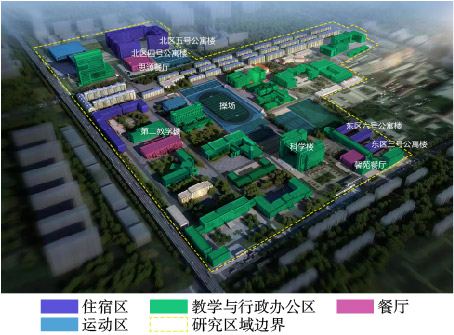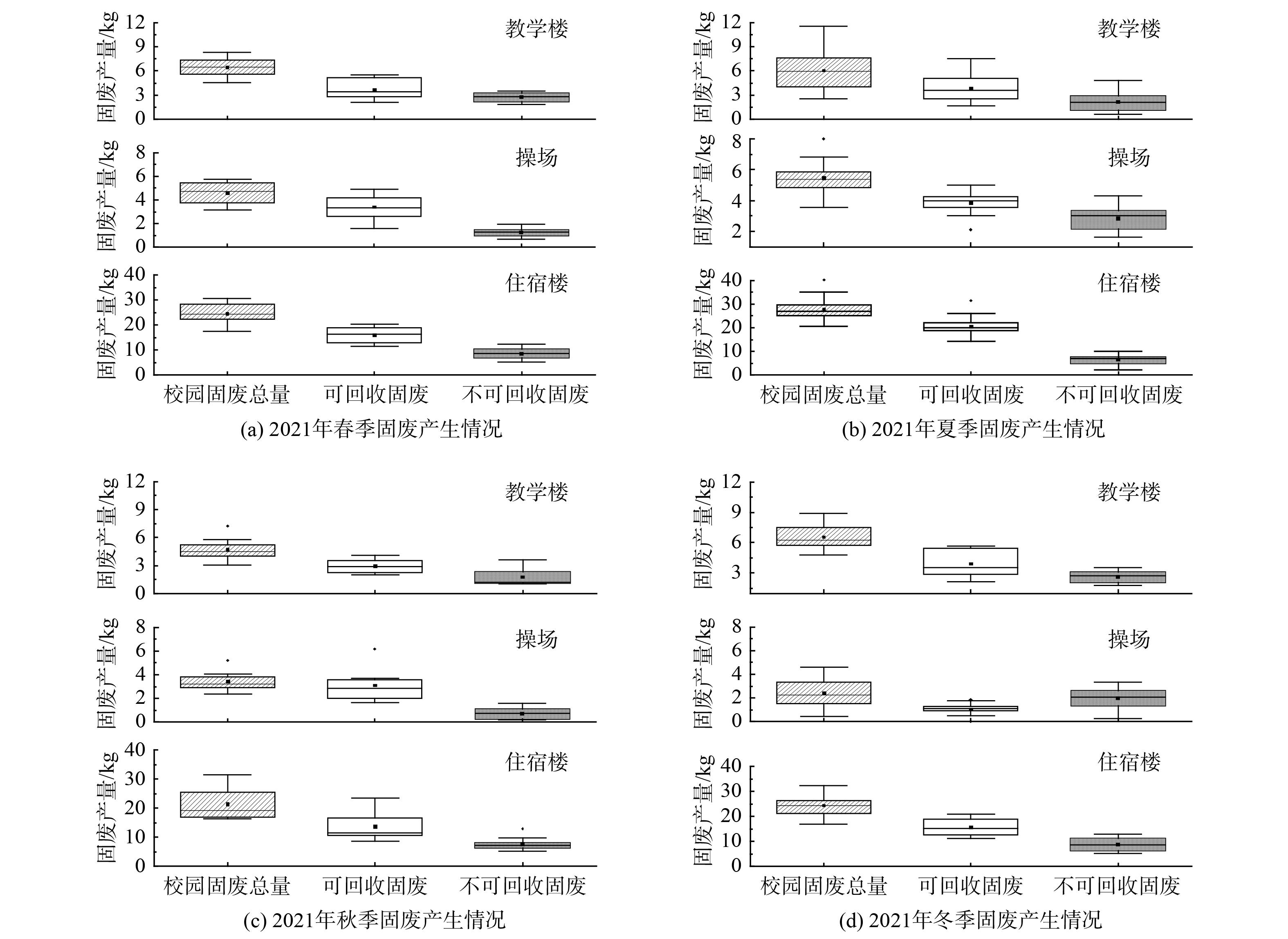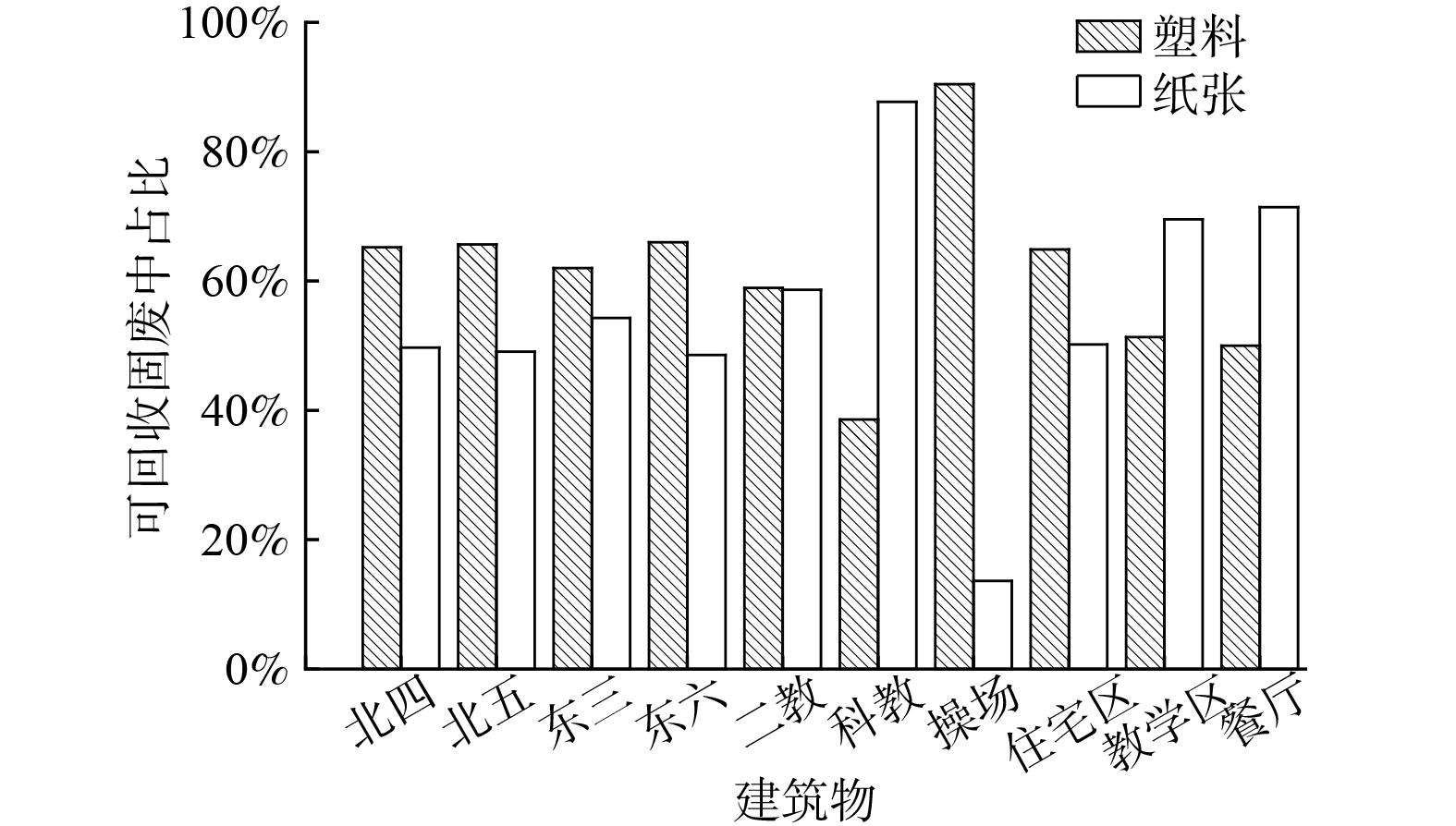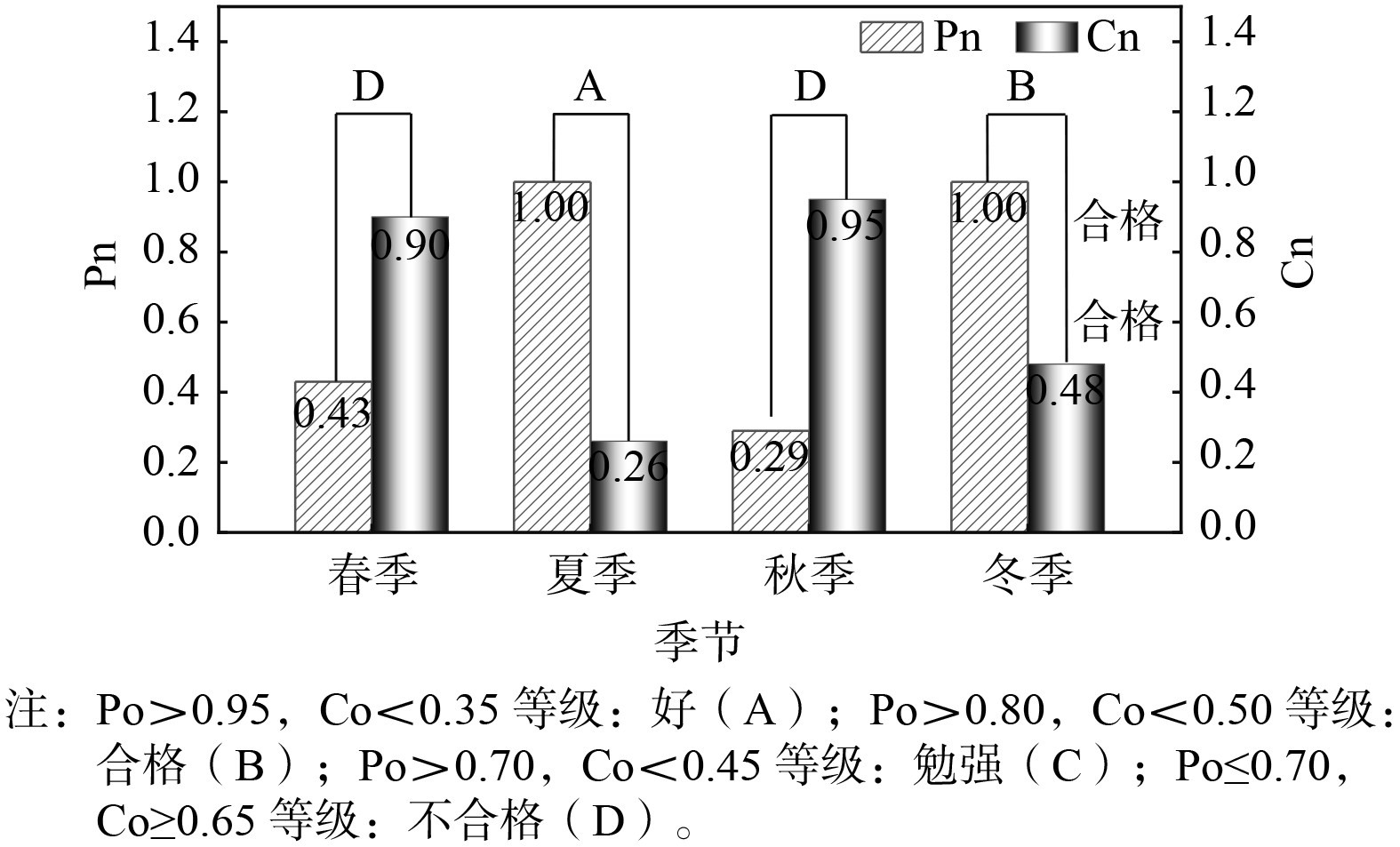-
2018年国务院办公厅发布《“无废城市”建设试点工作方案》(国办发〔2018〕128号)[1],2019年4月30日,中华人民共和国生态环境部公布11个“无废城市”建设试点[2],经过为期2年的建设,试点工作已成功验收,试点实践形成了“无废城市”建设指标体系和一批可推广示范模式,其内核不仅更注重生态环境保护,还在于让经济发展过程资源利用率更高、社会效益更好,展现了“无废城市”城市管理理念的先进之处。2022年4月24日,生态环境部公布“十四五”时期“无废城市”建设名单,内蒙古自治区呼和浩特市、包头市、鄂尔多斯市均在“无废城市”建设名单中[3]。“无废城市”旨在通过源头减量、循环利用、绿色生产等方式,实现城市内资源的有效利用和环境的持续改善。当前,“无废校园”是一种建立在“无废城市”概念基础上的先进的校园理念[4-6],“无废校园”已成为“无废城市”建设的重要组成部分,两者的相互促进、协同发展已成为重要趋势[7-8]。它通过资源的高效利用、环境的保护与生态建设、绿色生活理念的倡导等方式,实现校园内废弃物的最小化,推动校园走向可持续发展。高校的固体废物具有种类较多且区域较为集中的特点。因此,针对校园固废产生特性、处置利用及管理方面的顶层设计需求较为迫切。
目前,“无废校园”建设相关研究主要集中在垃圾分类现状讨论、分阶段减量、分类回收等方面。张悦等[9]以中北大学信息商务学院为例探讨高校校园固废分类现状及对策,认为可在垃圾分类措施完善、优化垃圾箱设置的区域针对性和提高学生的环保意识等方面开展。仝伟亮等[10]提出可从源头分类减量、中间资源化回收减量、末端无害化堆肥减量开展,并建立校园固废三级管理体系。朱兴峰等[11]提出可设计出一款智能垃圾分类回收设备推动校园固废分类与资源回收利用。陈成等[12]分析了校园垃圾分类存在的问题,提出可通过建立学校特色的规章制度、加强基础设施建设、应用先进的技术、采取有效地激励与约束措施和加强垃圾分类的宣传教育等对策,提高学生垃圾分类素养。彭希等[13]提出可采用数字化技术提升校园垃圾管理水平。
当前,在高校校园固废处理研究领域,研究者们主要开展校园垃圾分类管理或提升管理水平等方面研究,而在固体废物灰色模型预测方面,主要针对某个区域或某个城市开展研究。如封辰阳等[14]基于浦东地区历史数据,采用灰色预测模型和优化模型,预测了该区未来10年的垃圾产生量及最优回收方案,并得出了政府需要投入的成本;燕飞等[15]基于灰色预测理论,分别用GM(1,1)模型、分数阶GM(1,1)模型和新陈代谢GM(1,1)模型对广州市2015—2019年城镇生活垃圾清运量数据进行建模、检验和比较,结果表明新陈代谢GM(1,1)模型预测精度最高,预测2020—2024年广州市城镇生活垃圾清运量仍呈现长的趋势,在2024年将会突破1 000×104 t。然而,针对“无废校园”建立固废产量等相关预测模型尚未报道,校园固废产量预测是一个重要的环境管理问题,其直接涉及校园环境的全时空质量与学生健康。因此,通过预测固废产生,可以有效规划和调整管理应对方案,改善校园环境质量;同时,还可以通过强化收运与资源化利用体系建设,针对性建立完善回收网络、建立多种回收渠道、推广先进回收技术,有效降低或消除废弃物的对生态环境的影响,在保护自然资源与资源利用最大化的同时,也可推动循环经济发展,促进绿色产业和低碳经济的实现。
在全国“无废城市”持续推进与呼和浩特市已入选“十四五”无废城市建设的背景下,本研究以内蒙古工业大学为例,通过文献调研、实地走访、现场调查等手段,深入研究内蒙古工业大学校园固废产生量、产生规律及校园固废处理方式,并基于GM(1,1)灰色预测模型,结合现有数据特点与规律构建校园固废产量预测模型,以期为“无废校园”建设提供参考。
-
内蒙古工业大学(新城校区)位于内蒙古自治区呼和浩特市,校区研究区域建筑分布见图1。校园占地面积约215.13 hm2,建筑面积92.37×104 m2,在校师生约1.30×104人,校园固体废物的产出区域包括3区公寓(东区、西区、北区)、各教学楼(第一教学楼、第二教学楼、第三教学楼、第四教学楼、科学楼)、各实验楼(工程技术楼A、B座等)、各餐厅、绿化带和施工场地(施工时)等。
-
以文献调研、实地走访与调查、问卷调研等多种研究方法及结合灰色预测模型建构,针对住教学区、宿舍区、餐厅等区域等产生的纸张和纸板、塑料制品、厨余垃圾、纺织品等可回收垃圾与电子废物、有害废物、玻璃制品、建筑废弃物等不可回收垃圾。
1)文献调研。确定本研究涉及范围与主题,以CNKI、万方数据知识服务平台、Web of Science等作为文献资料数据库,针对检索结果开展筛选和评估,分析及研究关键文献资料,梳理总结“无废校园”建设现状。
2)实地走访与调查。实地走访与调查内蒙古工业大学(新城校区)垃圾产生、处理及回收过程与方式,以1年为期限,调研频次每周不少于3次,调研不同季节不同时间节点垃圾的产生、收集及处置方式,通过校园代表性的楼宇、区域作为调查重点,开展实地考察并采集数据,基于调研成果分析与整理,摸清垃圾底数与特点。同时,数据的采集与调研时间固定为调研当天垃圾产生过程基本结束、垃圾清运过程之前以及避开可能出现特殊情况导致调研数据受到较大影响的时间段或日期。
3)灰色预测模型。灰色预测法是一种用于预测时间序列数据的方法,可处理具有不确定性和随机性的数据。在生态环境管理领域,灰色模型可以用于预测垃圾产量等具有不确定性的问题。通过建立符合的微分方程模型来预测未来的发展趋势,最终得到预测值[16]。本研究通过采用灰色系统预测模型[17],以灰色系统方法和模型技术,基于人流量、垃圾产量等方面综合评估,选取最具有代表性的某一教学楼连续1周垃圾产量数据,建立灰色预测模型,从而预测该建筑未来几天或更长时间周期的产量,根据结果精确性确定全校预估结果准确性。
灰色预测模型计算过程中,
{{\rm{x}}}^{\left(0\right)} 即为待处理的原数据,设离散数据序列为x,已知{x}^{\left(0\right)} 的情况下,累加次数为1时,可计算得{x}^{\left(1\right)} 。其中,{x}_{1}^{\left(1\right)}={x}_{1}^{\left(0\right)} ,以序列{{\rm{x}}}^{\left(1\right)} 为基础建立灰色的生成模型,见式(1)。式(2)称为一阶灰色微分方程,记为GM (1,1)。式(2)中a和u为待辨识参数。
设参数向量
\hat {\mathrm{a}} ,{y}_{N} , B分别为:求出对应
{\mathrm{y}}_{\mathrm{N}} 值,由式(6)求得\hat {\mathrm{a}} 的最小二乘解,经Matlab计算,得到春、夏、秋、冬四季的\hat{\mathrm{a}} 值,有响应方程式(7),将春、夏、秋、冬四季的
\mathrm{a} ,\mathrm{u} 代入式(7),通过式(8)求出当次计算预测的垃圾产量的值。4)对比分析法。对比分析法是一种基本的科学探索方法,它是通过将一组具有相似因素的不同性质物体或对象进行对照比较,以确定它们在构造、性质等方面的差异和相似之处。本文通过内蒙古工业大学与安阳工学院各建筑区固废日均产量进行对比,明晰不同区域高校固废产生的特征。
-
为摸清内蒙古工业大学新城校区校园固体废物产生规律,于2021年开展随机调研该校区某教学楼、操场、某住宿楼的校园固体废物产生情况,分析结果见图2。
通过图2可看出春、夏、秋、冬四季下不同建筑物固废产生量情况,其中教学楼、操场、住宿楼日固废产生均值分别为(6.08±0.77)、(4.50±0.82)、(23.58±5.41)kg,包括可回收固废日产生均值为(3.69±0.96)、(1.3±0.08)、(14.70±3.61)kg,不可回收固废日产生均值为(2.38±0.33)、(3.21±0.83)、(8.88±2.70)kg。综合四季来看,夏季垃圾产量处于全年的高位,在固废总量上体现最明显,其数值为4个季节中最高。
在时间方面分析,春季的产生规律最能体现出住宿区、教学区、运动区的固废量产生特征在时间尺度方面体现为季节性波动较大。图2(a)为春季3区固废产量对比,其中操场的固废总量存在较大波动,且固废总量均值明显偏低,教学楼和宿舍的固废总量较为稳定;可回收固废量方面,教学楼和宿舍的可循环利用固废量远高于操场,且存在较大波动,操场可回收固废量相对稳定但均值较低;不可回收固废方面,相比可回收固废表现出固废产生量较低。图2(b)相较(a)、(c)、(d)图,无论是固废总量还是可回收固废或不可回收固废量均最高;夏季住宿区、运动区的固废量都会呈现出明显的增加趋势,这与夏季昼长夜短,人们活动时间较长有一定关联;同时从全年来看,夏季校园住宿区和教学区生活垃圾产量的高峰期(即5月底)是毕业季,据统计,固废总量均值较其他季节下约高出1.2~2.8倍,该时期学生离校时平均70%~85%的物品被丢弃,日固废产生量也大幅增加。因此,建议可借鉴埃斯库埃拉滨海高级理工学院(ESPOL, Escuela Superior Politécnica del Litoral)建立临时废物收集中心,促进部分有价值的物品二次再利用[18];秋季各类垃圾的产量数据相较其他季节,数据较为稳定,为四季垃圾产量的较低时段;冬季固废量与春、夏两季节比较相对更少,平均每日固废量比夏季固废量减少40%左右。这可能是因为冬季气温偏低,人们户外运动意愿不强烈,因此在运动区活动的人也比夏季时要少得多,表现为固废产量冬季时显著降低,故固废产生总量也自然减少。另外,固废的日产量呈现出非常显著的时间阶段性,具体为周末产量远大于工作日的产量,主要原因是周末学生外出购物频次较高,由此产生大量购物、食品包装垃圾丢弃现象,工作日学生大都在校内上课,购物消费较少,故生活垃圾产量少于休息日。此外,每年学生开学时期校园固废产生量增长明显,寒暑假期间校园内固废产量最少。
在空间方面分析,校园固废产生量较大、产生空间具有集中性、产生时间具有阶段性。调研区域内每日产生固废总量均值为35.26 kg,其中可回收固废均值22.97 kg,可回收固废中纸张和塑料分别占比为33.59%和66.41%。校园固废产生特征主要表现为校园人员较为集中,校园固废会随着人流量的增大而增多,校园废弃物也会急剧增加,体现出校园固废空间集中的特点。例如由于夏季高温炎热,学生相对喜欢饮用矿泉水或冰镇饮料等,因此住宿区、运动区的固废量均会呈现明显的增加趋势,结合毕业季,宿舍区的垃圾产量也会有明显地升高。
综上所述,校园不同区域之间固废产量的差异会随不同季节表现出一定的季节性差异。该数据特征对于进一步深入了解校园固废管理和环境保护方面的差异提供了有价值的信息,有助于制定相应的管理措施和政策[19]。因此,建议在校园固废管理中需根据不同季节的特点采取相应措施,加强垃圾分类、鼓励回收和减少不可回收固废的产生,可大幅降低固废对环境的影响,提高资源利用效率[20]。
-
1)校园固体废物产生类别现状。表1为内蒙古工业大学新城校区单建筑物校园固废产量现状,分析表明单个建筑物可回收固废产生总量为32.18 kg,占总体固废产生量的50.59%;不可回收固废产生总量为16.63 kg,占总体固废产生量的26.20%;不可分类固废产生总量为14.67 kg,占总体固废产生量的23.11%;除教学区和宿舍以外其他区域可回收校园固废产量较少,其中餐厅的可回收和不可回收校园固废产量最低。从固废产生总量来看,可回收固废占比较大,因此,校园固废具有易于分类、便于管理的特点。
图3为各建筑物可回收固废中塑料和纸张占比情况。发现在校园可回收固废中塑料和纸张的主要分布区域存在明显差异,塑料的产生主要分布在操场和宿舍区域。这可能是因为在操场的学生运动后习惯补充大量水分而产生的矿泉水瓶、饮料瓶等固废,同时由于学生在宿舍停留时间较长,产生固废的时间占比也相对较大;废纸的产生则是主要分布在教学区和宿舍区,从纸张主要类型是快递纸盒和书本便可以看出其产生量大的原因。因此,不同类别校园固废占比分布与其高校人员学习、生活等习惯息息相关。
2)与其他院校校园固废产生特征对比分析。通过调研分析学生平时非上课时间的停留时间较长的区域,结果图4(a)分析可得,88.10%的学生非上课时间集中活动在教学科研区和宿舍区,只有11.90%的学生集中活动在公共区、餐饮区以及行政办公区。图4(b)内蒙古工业大学各分区校园固废产生量与安阳工学院2020年的数据对比发现[22],2所学校各分区固废产生量均存在因不同区域功能属性的不同而导致的差异较大,相同区域其固废产生量还是相差不大,其中表现较为明显的是2学校宿舍区和餐饮区固废产量最多,产生了约92.53%以上的固废量,公共区和教学科研区固废产量次之,行政办公区最少。结合图4(a)反映出宿舍区为学生主要居住和活动的主要区域,时间占比长,因此固废产生量较多是毋庸置疑的;对于餐饮区作为人们吃饭和短时间集中人数最多区域之一,固废产生量较高的原因除了一些客观因素比如其产生量占总体固废量近40%,还存在着高校学生就餐浪费率较高等因素,因此高校学生环保意识的应需不断加强,以及“光盘行动”等减少餐后厨余垃圾浪费等一系列环保行动应需多宣传和普及。此外,2所学校日均固废产生量分别为7 655.47和7 041.00 kg,人均分别约0.25和0.30 kg,从数据上来讲,2校区人均日产量仅为文献公布的居民日均固废产生量平均值的24%~30%[21,23],学校生活较社会面生活习惯较单一,学生主要以读书为主,行为方式较简单。因此,校园固废产生垃圾种类偏少,产量相对较低,符合校园固废产生的特点。
-
灰色预测模型一般用在环境影响评价中,确定城市固废与生态环境的正相关关系,设计城市固废生态环境影响评价算法完成影响评价,并为环境影响设计提供理论基础[24-25]。建立灰色模型后,就可以利用该模型对未来的固体废物产生量进行预测,根据模型的输出结果,预测未来的固体废物产生量。本研究以某教学楼一年四季每周固废实际产量数据为依据,建立GM(1,1)灰色预测模型,开展预测校园固废产量,计算结果见表2。
通过灰色预测模型计算,以下分别为四季核算过程,
{\mathrm{x}}^{\left(0\right)} 即为待处理的原数据,设离散数据序列为x,累加次数为0时,则春、夏、秋、冬四季的{\mathrm{x}}^{\left(0\right)}\mathrm{值}\mathrm{为} :累加次数为1时,则:
对应,
{\mathrm{y}}_{\mathrm{N}} 值为:春、夏、秋、冬四季的
\hat{\mathrm{a}} 为:对于春季拟合数据,残差均值
\overline{\varepsilon }^{\left(0\right)} = −0.00017,残差标准差S1=1.26;原始数据均值\overline{x}^{\left(0\right)} =6.76, 原始数据标准差S2=1.40;后验差比值\mathrm{c}=\dfrac{{\mathrm{S}}_{1}}{{\mathrm{S}}_{2}}=0.90\geqslant 0.65 ;小误差概率\mathrm{P}=\mathrm{P}{|{\mathrm{\varepsilon }}_{\mathrm{i}}^{0}-\overline{\varepsilon }^{\left(0\right)}| \lt 0.6745{\mathrm{S}}_{2}}=0.43<0.70 ;对于夏季拟合数据,残差均值
\overline{\varepsilon }^{\left(0\right)} = 0.03,残差标准差S1=0.53;原始数据均值\overline{x}^{\left(0\right)} = 8.09, 原始数据标准差S2=2.01;后验差比值\mathrm{c}=\dfrac{{\mathrm{S}}_{1}}{{\mathrm{S}}_{2}}=0.26 \lt 0.35 ;小误差概率\mathrm{P}=\mathrm{P}{|{\mathrm{\varepsilon }}_{\mathrm{i}}^{0}-\overline{\varepsilon }^{\left(0\right)}| \lt 0.6745{\mathrm{S}}_{2}}=1.00 \gt 0.95 ;对于秋季拟合数据,残差均值
\overline{\varepsilon }^{\left(0\right)} =−0.00014,残差标准差S1=1.46;原始数据均值\overline{x}^{\left(0\right)} = 6.35, 原始数据标准差S2=1.53;后验差比值\mathrm{c}=\dfrac{{\mathrm{S}}_{1}}{{\mathrm{S}}_{2}}= 0.95>0.65;小误差概率\mathrm{P}=\mathrm{P}{|{\mathrm{\varepsilon }}_{\mathrm{i}}^{0}-\overline{\varepsilon }^{\left(0\right)}| \lt 0.6745{\mathrm{S}}_{2}}=0.29 \lt 0.7 ;对于冬季拟合数据,残差均值
\overline{\varepsilon }^{\left(0\right)} =−0.0017,残差标准差S1=0.63;原始数据均值\overline{x}^{\left(0\right)} = 4.81, 原始数据标准差S2=1.31;后验差比值\mathrm{c}=\dfrac{{\mathrm{S}}_{1}}{{\mathrm{S}}_{2}}=0.48 \lt 0.5 ;小误差概率\mathrm{P}=\mathrm{P}{|{\mathrm{\varepsilon }}_{\mathrm{i}}^{0}-\overline{\varepsilon }^{\left(0\right)}| \lt 0.6745{\mathrm{S}}_{2}}=1.00 \gt 0.8 由图5可看出,精度检验等级表明灰色系统预测对夏季、冬季的校园固废拟合精度为好和合格,预测结果正确可靠;春季、秋季的拟合精度效果相对较差。结合实地调研数据可知,因为春季温度变化大等因素,秋季处于新生入学季,人数变化较大,如2023年学生毕业人数为6 836人,其中本科生5 653人,研究生1 183人,学生基本上为秋季入学、夏季毕业,因此该阶段校园固废产生具有量大与种类丰富的特点,因此该阶段校园固废产生规律具有不定性,预测数据与实际固废产量存在一定差异,符合区域季节波动实际情况。因此,通过该模型可实现对夏季和冬季基于某月连续1周的校园固废产量预测未来几天乃至整个季节的固废量做出较为准确预测,精度良好。综上所述,对单一教学楼的分析,可一定程度代表校园产量变化趋势,通过“无废校园”固废产量模型构建,可实现校园固废产量趋势的预判,进而动态调整相应的校园固废收集管理策略,为“无废校园”建设提供参考。
-
1)内蒙古工业大学校园固废具有产生数量大、产生空间集中、产生时间具有阶段性等特点,且不同区域之间固废产量呈现季节性差异。因此,建议高校根据不同季节垃圾产生的规律及特点采取相应的收集处置措施,可通过建立宣传站、电子回收垃圾装置、建立主动式垃圾回收激励措施等,提升校园固废垃圾收集、处理效率,降低综合成本与效益,助力高校“无废校园”建设。
2)校园固废的产生类别具有易于分类、便于管理的特点,且不同类别校园固废占比与高校人员学习、生活等习惯息息相关。学生非上课时间基本停留在教学科研区和宿舍区,相较于社会面,校园产生的固废种类单一,相对更易进行分类和处理。因此,高校应加强宣传教育、制定相关规定,提高学生固废分类意识和认识度,从而有效促进校园固废源头减量。
3) GM(1,1)灰色预测模型构建可准确反映夏季、冬季校园固废产生规律与特征,实现校园固废产量趋势预判,支撑校园固废收集管理策略动态调整,为“无废校园”建设提供参考。
“无废城市”建设下的“无废校园”固废产量预测模型——以内蒙古工业大学为例
Prediction model of solid waste production of “zero-waste campus” under the construction of “zero-waste city”——Taking Inner Mongolia University of Technology as an example
-
摘要: 开展“无废城市”建设是我国建设生态文明、实现美丽中国目标的重要工作内容,是推动实现绿色低碳高质量发展的有力抓手,而“无废校园”建设则是“无废城市”建设的必要补充,旨在全面实现校园固废资源化与无害化,打造低碳、环保、节能、友好的校园环境。本研究以内蒙古工业大学为例,通过文献调研、实地走访调查和预测模型构建相结合的方式,系统研究了内蒙古工业大学校园固废产生规律及固废产量预测模型。结果表明,校园固废具有产生数量大、产生空间集中、产生时间具有阶段性等特点,其中教学楼、操场、住宿楼日固废产生均值分别为(6.08±0.77)、(4.50±0.82)、(23.58±5.41) kg,且不同区域之间固废产量呈现季节性差异;校园固废种类较社会面单一,易于分类管理,其中88.10%的学生非上课时间集中活动在教学科研区与宿舍区,并产生了约92.53%的固废量;基于实际数据及GM(1,1)灰色预测模型构建发现系统对夏季和冬季校园固废拟合精度分别为好和合格,预测结果可靠。本研究结果可为“无废城市”建设下的“无废校园”建设提供参考。Abstract: The construction of “zero-waste city” is an important work content of China's construction of ecological civilization and the goal of a beautiful China, and is a powerful starting point for promoting the realization of green, low-carbon and high-quality development, while the construction of "zero-waste campus" is a necessary supplement to the construction of “zero-waste city”, aiming to fully realize the resource and harmlessness of campus solid waste, and create a low-carbon, environmentally friendly, energy-saving and friendly campus environment. Taking Inner Mongolia University of Technology as an example, this study systematically studied the solid waste generation law and solid waste yield prediction model of Inner Mongolia University of Technology campus through a combination of literature research, field survey and prediction model construction. The results showed that the average daily solid waste generation in teaching buildings, playgrounds and accommodation buildings was (6.08±0.77), (4.50±0.82), and (23.58±5.41) kg, respectively, and the solid waste production showed seasonal differences between different regions; The types of solid waste generated were single and easy to classify and manage in comparison to that from society, where 88.10% of the students concentrated on teaching and research areas and dormitory areas during non-school hours with a generation rate of 92.53% of the total solid waste; Based on the actual data and the GM(1,1) gray prediction model, it was found that the system has good fitting accuracy and qualification for campus solid waste in summer and winter, and the prediction results were reliable. Therefore, this study can provide a reference for the construction of “zero-waste campus” under the construction of “zero-waste city”.
-
Key words:
- zero-waste cities /
- zero-waste campus /
- campus solid waste /
- yield forecast model
-
2018年国务院办公厅发布《“无废城市”建设试点工作方案》(国办发〔2018〕128号)[1],2019年4月30日,中华人民共和国生态环境部公布11个“无废城市”建设试点[2],经过为期2年的建设,试点工作已成功验收,试点实践形成了“无废城市”建设指标体系和一批可推广示范模式,其内核不仅更注重生态环境保护,还在于让经济发展过程资源利用率更高、社会效益更好,展现了“无废城市”城市管理理念的先进之处。2022年4月24日,生态环境部公布“十四五”时期“无废城市”建设名单,内蒙古自治区呼和浩特市、包头市、鄂尔多斯市均在“无废城市”建设名单中[3]。“无废城市”旨在通过源头减量、循环利用、绿色生产等方式,实现城市内资源的有效利用和环境的持续改善。当前,“无废校园”是一种建立在“无废城市”概念基础上的先进的校园理念[4-6],“无废校园”已成为“无废城市”建设的重要组成部分,两者的相互促进、协同发展已成为重要趋势[7-8]。它通过资源的高效利用、环境的保护与生态建设、绿色生活理念的倡导等方式,实现校园内废弃物的最小化,推动校园走向可持续发展。高校的固体废物具有种类较多且区域较为集中的特点。因此,针对校园固废产生特性、处置利用及管理方面的顶层设计需求较为迫切。
目前,“无废校园”建设相关研究主要集中在垃圾分类现状讨论、分阶段减量、分类回收等方面。张悦等[9]以中北大学信息商务学院为例探讨高校校园固废分类现状及对策,认为可在垃圾分类措施完善、优化垃圾箱设置的区域针对性和提高学生的环保意识等方面开展。仝伟亮等[10]提出可从源头分类减量、中间资源化回收减量、末端无害化堆肥减量开展,并建立校园固废三级管理体系。朱兴峰等[11]提出可设计出一款智能垃圾分类回收设备推动校园固废分类与资源回收利用。陈成等[12]分析了校园垃圾分类存在的问题,提出可通过建立学校特色的规章制度、加强基础设施建设、应用先进的技术、采取有效地激励与约束措施和加强垃圾分类的宣传教育等对策,提高学生垃圾分类素养。彭希等[13]提出可采用数字化技术提升校园垃圾管理水平。
当前,在高校校园固废处理研究领域,研究者们主要开展校园垃圾分类管理或提升管理水平等方面研究,而在固体废物灰色模型预测方面,主要针对某个区域或某个城市开展研究。如封辰阳等[14]基于浦东地区历史数据,采用灰色预测模型和优化模型,预测了该区未来10年的垃圾产生量及最优回收方案,并得出了政府需要投入的成本;燕飞等[15]基于灰色预测理论,分别用GM(1,1)模型、分数阶GM(1,1)模型和新陈代谢GM(1,1)模型对广州市2015—2019年城镇生活垃圾清运量数据进行建模、检验和比较,结果表明新陈代谢GM(1,1)模型预测精度最高,预测2020—2024年广州市城镇生活垃圾清运量仍呈现长的趋势,在2024年将会突破1 000×104 t。然而,针对“无废校园”建立固废产量等相关预测模型尚未报道,校园固废产量预测是一个重要的环境管理问题,其直接涉及校园环境的全时空质量与学生健康。因此,通过预测固废产生,可以有效规划和调整管理应对方案,改善校园环境质量;同时,还可以通过强化收运与资源化利用体系建设,针对性建立完善回收网络、建立多种回收渠道、推广先进回收技术,有效降低或消除废弃物的对生态环境的影响,在保护自然资源与资源利用最大化的同时,也可推动循环经济发展,促进绿色产业和低碳经济的实现。
在全国“无废城市”持续推进与呼和浩特市已入选“十四五”无废城市建设的背景下,本研究以内蒙古工业大学为例,通过文献调研、实地走访、现场调查等手段,深入研究内蒙古工业大学校园固废产生量、产生规律及校园固废处理方式,并基于GM(1,1)灰色预测模型,结合现有数据特点与规律构建校园固废产量预测模型,以期为“无废校园”建设提供参考。
1. 研究概况
1.1 研究区概况
内蒙古工业大学(新城校区)位于内蒙古自治区呼和浩特市,校区研究区域建筑分布见图1。校园占地面积约215.13 hm2,建筑面积92.37×104 m2,在校师生约1.30×104人,校园固体废物的产出区域包括3区公寓(东区、西区、北区)、各教学楼(第一教学楼、第二教学楼、第三教学楼、第四教学楼、科学楼)、各实验楼(工程技术楼A、B座等)、各餐厅、绿化带和施工场地(施工时)等。
1.2 研究方法与对象
以文献调研、实地走访与调查、问卷调研等多种研究方法及结合灰色预测模型建构,针对住教学区、宿舍区、餐厅等区域等产生的纸张和纸板、塑料制品、厨余垃圾、纺织品等可回收垃圾与电子废物、有害废物、玻璃制品、建筑废弃物等不可回收垃圾。
1)文献调研。确定本研究涉及范围与主题,以CNKI、万方数据知识服务平台、Web of Science等作为文献资料数据库,针对检索结果开展筛选和评估,分析及研究关键文献资料,梳理总结“无废校园”建设现状。
2)实地走访与调查。实地走访与调查内蒙古工业大学(新城校区)垃圾产生、处理及回收过程与方式,以1年为期限,调研频次每周不少于3次,调研不同季节不同时间节点垃圾的产生、收集及处置方式,通过校园代表性的楼宇、区域作为调查重点,开展实地考察并采集数据,基于调研成果分析与整理,摸清垃圾底数与特点。同时,数据的采集与调研时间固定为调研当天垃圾产生过程基本结束、垃圾清运过程之前以及避开可能出现特殊情况导致调研数据受到较大影响的时间段或日期。
3)灰色预测模型。灰色预测法是一种用于预测时间序列数据的方法,可处理具有不确定性和随机性的数据。在生态环境管理领域,灰色模型可以用于预测垃圾产量等具有不确定性的问题。通过建立符合的微分方程模型来预测未来的发展趋势,最终得到预测值[16]。本研究通过采用灰色系统预测模型[17],以灰色系统方法和模型技术,基于人流量、垃圾产量等方面综合评估,选取最具有代表性的某一教学楼连续1周垃圾产量数据,建立灰色预测模型,从而预测该建筑未来几天或更长时间周期的产量,根据结果精确性确定全校预估结果准确性。
灰色预测模型计算过程中,
x(0) x(0) x(1) x(1)1=x(0)1 x(1) x(1)k=∑kj=1x(0)jk=1,2,⋯,N (1) 式(2)称为一阶灰色微分方程,记为GM (1,1)。式(2)中a和u为待辨识参数。
dx(1)dt+ax(1)=u (2) 设参数向量
ˆa yN ˆa=[au]T (3) yN=(x(0)2,x(0)3,…,x(0)N)T (4) B=(−(x(1)2+x(1)1)/21⋮⋮−(x(1)N+x(1)N−1)/21) (5) 求出对应
yN ˆa ˆa ˆa=(BTB)−1BTyN (6) 有响应方程式(7),将春、夏、秋、冬四季的
a u ˆx(1)k+1=(x(1)1−ua)e−ak+ua (7) ˆx(0)k+1=ˆx(1)k+1−ˆx(1)k (8) 4)对比分析法。对比分析法是一种基本的科学探索方法,它是通过将一组具有相似因素的不同性质物体或对象进行对照比较,以确定它们在构造、性质等方面的差异和相似之处。本文通过内蒙古工业大学与安阳工学院各建筑区固废日均产量进行对比,明晰不同区域高校固废产生的特征。
2. 校园固体废物产生规律及模型构建与预测
2.1 校园固体废物产生特性
为摸清内蒙古工业大学新城校区校园固体废物产生规律,于2021年开展随机调研该校区某教学楼、操场、某住宿楼的校园固体废物产生情况,分析结果见图2。
通过图2可看出春、夏、秋、冬四季下不同建筑物固废产生量情况,其中教学楼、操场、住宿楼日固废产生均值分别为(6.08±0.77)、(4.50±0.82)、(23.58±5.41)kg,包括可回收固废日产生均值为(3.69±0.96)、(1.3±0.08)、(14.70±3.61)kg,不可回收固废日产生均值为(2.38±0.33)、(3.21±0.83)、(8.88±2.70)kg。综合四季来看,夏季垃圾产量处于全年的高位,在固废总量上体现最明显,其数值为4个季节中最高。
在时间方面分析,春季的产生规律最能体现出住宿区、教学区、运动区的固废量产生特征在时间尺度方面体现为季节性波动较大。图2(a)为春季3区固废产量对比,其中操场的固废总量存在较大波动,且固废总量均值明显偏低,教学楼和宿舍的固废总量较为稳定;可回收固废量方面,教学楼和宿舍的可循环利用固废量远高于操场,且存在较大波动,操场可回收固废量相对稳定但均值较低;不可回收固废方面,相比可回收固废表现出固废产生量较低。图2(b)相较(a)、(c)、(d)图,无论是固废总量还是可回收固废或不可回收固废量均最高;夏季住宿区、运动区的固废量都会呈现出明显的增加趋势,这与夏季昼长夜短,人们活动时间较长有一定关联;同时从全年来看,夏季校园住宿区和教学区生活垃圾产量的高峰期(即5月底)是毕业季,据统计,固废总量均值较其他季节下约高出1.2~2.8倍,该时期学生离校时平均70%~85%的物品被丢弃,日固废产生量也大幅增加。因此,建议可借鉴埃斯库埃拉滨海高级理工学院(ESPOL, Escuela Superior Politécnica del Litoral)建立临时废物收集中心,促进部分有价值的物品二次再利用[18];秋季各类垃圾的产量数据相较其他季节,数据较为稳定,为四季垃圾产量的较低时段;冬季固废量与春、夏两季节比较相对更少,平均每日固废量比夏季固废量减少40%左右。这可能是因为冬季气温偏低,人们户外运动意愿不强烈,因此在运动区活动的人也比夏季时要少得多,表现为固废产量冬季时显著降低,故固废产生总量也自然减少。另外,固废的日产量呈现出非常显著的时间阶段性,具体为周末产量远大于工作日的产量,主要原因是周末学生外出购物频次较高,由此产生大量购物、食品包装垃圾丢弃现象,工作日学生大都在校内上课,购物消费较少,故生活垃圾产量少于休息日。此外,每年学生开学时期校园固废产生量增长明显,寒暑假期间校园内固废产量最少。
在空间方面分析,校园固废产生量较大、产生空间具有集中性、产生时间具有阶段性。调研区域内每日产生固废总量均值为35.26 kg,其中可回收固废均值22.97 kg,可回收固废中纸张和塑料分别占比为33.59%和66.41%。校园固废产生特征主要表现为校园人员较为集中,校园固废会随着人流量的增大而增多,校园废弃物也会急剧增加,体现出校园固废空间集中的特点。例如由于夏季高温炎热,学生相对喜欢饮用矿泉水或冰镇饮料等,因此住宿区、运动区的固废量均会呈现明显的增加趋势,结合毕业季,宿舍区的垃圾产量也会有明显地升高。
综上所述,校园不同区域之间固废产量的差异会随不同季节表现出一定的季节性差异。该数据特征对于进一步深入了解校园固废管理和环境保护方面的差异提供了有价值的信息,有助于制定相应的管理措施和政策[19]。因此,建议在校园固废管理中需根据不同季节的特点采取相应措施,加强垃圾分类、鼓励回收和减少不可回收固废的产生,可大幅降低固废对环境的影响,提高资源利用效率[20]。
2.2 不同建筑物固废产生现状分析
1)校园固体废物产生类别现状。表1为内蒙古工业大学新城校区单建筑物校园固废产量现状,分析表明单个建筑物可回收固废产生总量为32.18 kg,占总体固废产生量的50.59%;不可回收固废产生总量为16.63 kg,占总体固废产生量的26.20%;不可分类固废产生总量为14.67 kg,占总体固废产生量的23.11%;除教学区和宿舍以外其他区域可回收校园固废产量较少,其中餐厅的可回收和不可回收校园固废产量最低。从固废产生总量来看,可回收固废占比较大,因此,校园固废具有易于分类、便于管理的特点。
表 1 内蒙古工业大学新城校区单建筑物校园固废产量数据Table 1. Solid waste production data of single building campus of Xincheng Campus of Inner Mongolia University of Technology建筑物 可回收平均值/kg 不可回收平均值/kg 不可分类平均值/kg 数据属性 北区公寓四号楼 4.87 3.20 2.60 单层 北区公寓五号楼 9.10 4.20 1.00 单层 东区公寓三号楼 4.20 1.67 0.67 单层 东区公寓六号楼 3.60 1.12 0.23 单层 第二教学楼 0.67 0.36 0.00 单层 科学楼 1.42 1.55 5.53 单层 操场 1.74 0.88 0.74 单层 思源餐厅 0.05 0.046 0.00 每人次 馨苑餐厅 0.009 0.048 0.00 每人次 住宿区 5.44 2.55 1.13 每层 教学区 1.05 0.96 2.77 每层 餐厅 0.030 0.047 0.00 每人次 图3为各建筑物可回收固废中塑料和纸张占比情况。发现在校园可回收固废中塑料和纸张的主要分布区域存在明显差异,塑料的产生主要分布在操场和宿舍区域。这可能是因为在操场的学生运动后习惯补充大量水分而产生的矿泉水瓶、饮料瓶等固废,同时由于学生在宿舍停留时间较长,产生固废的时间占比也相对较大;废纸的产生则是主要分布在教学区和宿舍区,从纸张主要类型是快递纸盒和书本便可以看出其产生量大的原因。因此,不同类别校园固废占比分布与其高校人员学习、生活等习惯息息相关。
2)与其他院校校园固废产生特征对比分析。通过调研分析学生平时非上课时间的停留时间较长的区域,结果图4(a)分析可得,88.10%的学生非上课时间集中活动在教学科研区和宿舍区,只有11.90%的学生集中活动在公共区、餐饮区以及行政办公区。图4(b)内蒙古工业大学各分区校园固废产生量与安阳工学院2020年的数据对比发现[22],2所学校各分区固废产生量均存在因不同区域功能属性的不同而导致的差异较大,相同区域其固废产生量还是相差不大,其中表现较为明显的是2学校宿舍区和餐饮区固废产量最多,产生了约92.53%以上的固废量,公共区和教学科研区固废产量次之,行政办公区最少。结合图4(a)反映出宿舍区为学生主要居住和活动的主要区域,时间占比长,因此固废产生量较多是毋庸置疑的;对于餐饮区作为人们吃饭和短时间集中人数最多区域之一,固废产生量较高的原因除了一些客观因素比如其产生量占总体固废量近40%,还存在着高校学生就餐浪费率较高等因素,因此高校学生环保意识的应需不断加强,以及“光盘行动”等减少餐后厨余垃圾浪费等一系列环保行动应需多宣传和普及。此外,2所学校日均固废产生量分别为7 655.47和7 041.00 kg,人均分别约0.25和0.30 kg,从数据上来讲,2校区人均日产量仅为文献公布的居民日均固废产生量平均值的24%~30%[21,23],学校生活较社会面生活习惯较单一,学生主要以读书为主,行为方式较简单。因此,校园固废产生垃圾种类偏少,产量相对较低,符合校园固废产生的特点。
2.3 校园固体废物产量模型构建及预测
灰色预测模型一般用在环境影响评价中,确定城市固废与生态环境的正相关关系,设计城市固废生态环境影响评价算法完成影响评价,并为环境影响设计提供理论基础[24-25]。建立灰色模型后,就可以利用该模型对未来的固体废物产生量进行预测,根据模型的输出结果,预测未来的固体废物产生量。本研究以某教学楼一年四季每周固废实际产量数据为依据,建立GM(1,1)灰色预测模型,开展预测校园固废产量,计算结果见表2。
表 2 内蒙古工业大学某教学楼不同季节下固废产量数据GM(1,1)灰色预测模型计算表Table 2. Calculation table of GM(1,1) gray prediction model of solid waste production data in different seasons of a teaching building of Inner Mongolia University of Technology季节 日期 x(0)/kg x(1)/kg 灰色预测 季节 日期 x(0)/kg x(1)/kg 灰色预测 x^(1)/kg x^(0)/kg ε^(0) x^(1)/kg x^(0)/kg ε^(0) 春季 3.05 8.23 8.23 8.23 8.23 0.00 秋季 9.08 5.22 5.22 5.22 5.22 0.00 3.06 6.33 14.56 14.85 6.62 −0.29 9.09 4.69 9.91 11.56 6.34 1.65 3.07 7.72 22.28 21.43 6.58 1.14 9.10 6.49 16.40 17.98 6.42 −0.07 3.08 4.89 27.12 27.96 6.53 −1.64 9.11 7.64 24.04 24.47 6.50 −1.15 3.09 8.28 35.45 34.46 6.49 1.79 9.12 7.88 31.92 31.05 6.57 −1.31 3.10 4.67 40.12 40.90 6.45 −1.78 9.13 8.30 40.22 37.70 6.65 −1.65 3.11 7.19 47.13 47.31 6.41 0.78 9.14 4.21 44.43 44.43 6.73 2.52 3.12 / / 53.68 6.36 / 9.15 / / 51.24 6.81 / 3.13 / / 60.00 6.32 / 9.16 / / 58.13 6.89 / 3.14 / / 66.28 6.28 / 9.17 / / 65.11 6.98 / 3.15 / / 72.52 6.24 / 9.18 / / 72.17 7.06 / 夏季 5.25 5.69 5.69 5.69 5.69 0.00 冬季 12.17 3.07 3.07 3.07 3.07 0.00 5.26 6.26 11.95 11.69 6.00 0.26 12.18 3.77 6.84 6.89 3.82 −0.05 5.27 7.52 19.47 18.50 6.81 0.71 12.19 4.27 11.11 11.15 4.26 0.01 5.28 7.04 26.51 26.24 7.74 −0.70 12.20 4.23 15.34 15.90 4.75 −0.52 5.29 8.02 34.53 35.04 8.80 −0.78 12.21 5.32 20.66 21.20 5.30 0.02 5.30 10.53 45.06 45.03 10.00 0.58 12.22 7.27 27.93 27.11 5.91 1.36 5.31 11.54 56.60 56.38 11.35 0.19 12.23 5.77 33.70 33.71 6.60 −0.83 6.01 / / 69.28 12.90 / 12.24 / / 41.07 7.36 / 6.02 / / 83.93 14.65 / 12.25 / / 49.29 8.21 / 6.03 / / 100.58 16.65 / 12.26 / / 58.46 9.17 / 6.04 / / 119.49 18.91 / 12.27 / / 68.68 10.23 / 通过灰色预测模型计算,以下分别为四季核算过程,
x(0) x(0)值为 x(0)={[8.236.337.724.898.284.677.19][5.696.267.527.048.0210.5311.54][5.224.696.497.647.888.304.21][3.073.774.274.235.327.275.77] (9) 累加次数为1时,则:
x(1)={[8.2314.5622.2827.1235.4540.1247.13][5.6911.9519.4726.5134.5345.0656.6][5.229.9116.4024.0431.9240.2244.43][3.076.8411.1115.3420.6627.9333.70] (10) B={[−11.391;−18.421;−24.701;−31.281;−37.781;−43.621][−8.821;−15.711;−22.991;−30.521;−39.7951;−50.831][−7.561;−13.151;−20.221;−27.981;−36.071;−42.321][−4.951;−8.971;−13.221;−18.001;−24.291;−30.811] (11) 对应,
yN yN={[6.337.724.898.284.677.19]T[6.267.527.048.0210.5311.54]T[4.696.497.647.888.304.21]T[3.774.274.235.327.275.77]T (12) 春、夏、秋、冬四季的
ˆa ˆa={[0.0066;6.6977][−0.1276;4.8982][−0.0119;6.2422][−0.1095;3.2756] (13) ˆx(1)k+1={1014.80−1006.57e−0.0066k−38.387+44.077e0.1276k−524.555+529.775e0.0119k−29.914+32.984e0.1095k (14) 对于春季拟合数据,残差均值
¯ε(0) ¯x(0) c=S1S2=0.90⩾ \mathrm{P}=\mathrm{P}{|{\mathrm{\varepsilon }}_{\mathrm{i}}^{0}-\overline{\varepsilon }^{\left(0\right)}|<0.6745{\mathrm{S}}_{2}}=0.43<0.70 对于夏季拟合数据,残差均值
\overline{\varepsilon }^{\left(0\right)} \overline{x}^{\left(0\right)} \mathrm{c}=\dfrac{{\mathrm{S}}_{1}}{{\mathrm{S}}_{2}}=0.26<0.35 \mathrm{P}=\mathrm{P}{|{\mathrm{\varepsilon }}_{\mathrm{i}}^{0}-\overline{\varepsilon }^{\left(0\right)}|<0.6745{\mathrm{S}}_{2}}=1.00>0.95 对于秋季拟合数据,残差均值
\overline{\varepsilon }^{\left(0\right)} \overline{x}^{\left(0\right)} \mathrm{c}=\dfrac{{\mathrm{S}}_{1}}{{\mathrm{S}}_{2}}= \mathrm{P}=\mathrm{P}{|{\mathrm{\varepsilon }}_{\mathrm{i}}^{0}-\overline{\varepsilon }^{\left(0\right)}|<0.6745{\mathrm{S}}_{2}}=0.29<0.7 对于冬季拟合数据,残差均值
\overline{\varepsilon }^{\left(0\right)} \overline{x}^{\left(0\right)} \mathrm{c}=\dfrac{{\mathrm{S}}_{1}}{{\mathrm{S}}_{2}}=0.48<0.5 \mathrm{P}=\mathrm{P}{|{\mathrm{\varepsilon }}_{\mathrm{i}}^{0}-\overline{\varepsilon }^{\left(0\right)}|< 0.6745{\mathrm{S}}_{2}}=1.00>0.8 由图5可看出,精度检验等级表明灰色系统预测对夏季、冬季的校园固废拟合精度为好和合格,预测结果正确可靠;春季、秋季的拟合精度效果相对较差。结合实地调研数据可知,因为春季温度变化大等因素,秋季处于新生入学季,人数变化较大,如2023年学生毕业人数为6 836人,其中本科生5 653人,研究生1 183人,学生基本上为秋季入学、夏季毕业,因此该阶段校园固废产生具有量大与种类丰富的特点,因此该阶段校园固废产生规律具有不定性,预测数据与实际固废产量存在一定差异,符合区域季节波动实际情况。因此,通过该模型可实现对夏季和冬季基于某月连续1周的校园固废产量预测未来几天乃至整个季节的固废量做出较为准确预测,精度良好。综上所述,对单一教学楼的分析,可一定程度代表校园产量变化趋势,通过“无废校园”固废产量模型构建,可实现校园固废产量趋势的预判,进而动态调整相应的校园固废收集管理策略,为“无废校园”建设提供参考。
3. 结论与建议
1)内蒙古工业大学校园固废具有产生数量大、产生空间集中、产生时间具有阶段性等特点,且不同区域之间固废产量呈现季节性差异。因此,建议高校根据不同季节垃圾产生的规律及特点采取相应的收集处置措施,可通过建立宣传站、电子回收垃圾装置、建立主动式垃圾回收激励措施等,提升校园固废垃圾收集、处理效率,降低综合成本与效益,助力高校“无废校园”建设。
2)校园固废的产生类别具有易于分类、便于管理的特点,且不同类别校园固废占比与高校人员学习、生活等习惯息息相关。学生非上课时间基本停留在教学科研区和宿舍区,相较于社会面,校园产生的固废种类单一,相对更易进行分类和处理。因此,高校应加强宣传教育、制定相关规定,提高学生固废分类意识和认识度,从而有效促进校园固废源头减量。
3) GM(1,1)灰色预测模型构建可准确反映夏季、冬季校园固废产生规律与特征,实现校园固废产量趋势预判,支撑校园固废收集管理策略动态调整,为“无废校园”建设提供参考。
-
表 1 内蒙古工业大学新城校区单建筑物校园固废产量数据
Table 1. Solid waste production data of single building campus of Xincheng Campus of Inner Mongolia University of Technology
建筑物 可回收平均值/kg 不可回收平均值/kg 不可分类平均值/kg 数据属性 北区公寓四号楼 4.87 3.20 2.60 单层 北区公寓五号楼 9.10 4.20 1.00 单层 东区公寓三号楼 4.20 1.67 0.67 单层 东区公寓六号楼 3.60 1.12 0.23 单层 第二教学楼 0.67 0.36 0.00 单层 科学楼 1.42 1.55 5.53 单层 操场 1.74 0.88 0.74 单层 思源餐厅 0.05 0.046 0.00 每人次 馨苑餐厅 0.009 0.048 0.00 每人次 住宿区 5.44 2.55 1.13 每层 教学区 1.05 0.96 2.77 每层 餐厅 0.030 0.047 0.00 每人次 表 2 内蒙古工业大学某教学楼不同季节下固废产量数据GM(1,1)灰色预测模型计算表
Table 2. Calculation table of GM(1,1) gray prediction model of solid waste production data in different seasons of a teaching building of Inner Mongolia University of Technology
季节 日期 x(0)/kg x(1)/kg 灰色预测 季节 日期 x(0)/kg x(1)/kg 灰色预测 x^(1)/kg x^(0)/kg ε^(0) x^(1)/kg x^(0)/kg ε^(0) 春季 3.05 8.23 8.23 8.23 8.23 0.00 秋季 9.08 5.22 5.22 5.22 5.22 0.00 3.06 6.33 14.56 14.85 6.62 −0.29 9.09 4.69 9.91 11.56 6.34 1.65 3.07 7.72 22.28 21.43 6.58 1.14 9.10 6.49 16.40 17.98 6.42 −0.07 3.08 4.89 27.12 27.96 6.53 −1.64 9.11 7.64 24.04 24.47 6.50 −1.15 3.09 8.28 35.45 34.46 6.49 1.79 9.12 7.88 31.92 31.05 6.57 −1.31 3.10 4.67 40.12 40.90 6.45 −1.78 9.13 8.30 40.22 37.70 6.65 −1.65 3.11 7.19 47.13 47.31 6.41 0.78 9.14 4.21 44.43 44.43 6.73 2.52 3.12 / / 53.68 6.36 / 9.15 / / 51.24 6.81 / 3.13 / / 60.00 6.32 / 9.16 / / 58.13 6.89 / 3.14 / / 66.28 6.28 / 9.17 / / 65.11 6.98 / 3.15 / / 72.52 6.24 / 9.18 / / 72.17 7.06 / 夏季 5.25 5.69 5.69 5.69 5.69 0.00 冬季 12.17 3.07 3.07 3.07 3.07 0.00 5.26 6.26 11.95 11.69 6.00 0.26 12.18 3.77 6.84 6.89 3.82 −0.05 5.27 7.52 19.47 18.50 6.81 0.71 12.19 4.27 11.11 11.15 4.26 0.01 5.28 7.04 26.51 26.24 7.74 −0.70 12.20 4.23 15.34 15.90 4.75 −0.52 5.29 8.02 34.53 35.04 8.80 −0.78 12.21 5.32 20.66 21.20 5.30 0.02 5.30 10.53 45.06 45.03 10.00 0.58 12.22 7.27 27.93 27.11 5.91 1.36 5.31 11.54 56.60 56.38 11.35 0.19 12.23 5.77 33.70 33.71 6.60 −0.83 6.01 / / 69.28 12.90 / 12.24 / / 41.07 7.36 / 6.02 / / 83.93 14.65 / 12.25 / / 49.29 8.21 / 6.03 / / 100.58 16.65 / 12.26 / / 58.46 9.17 / 6.04 / / 119.49 18.91 / 12.27 / / 68.68 10.23 / -
[1] 国务院办公厅. 关于印发“无废城市”建设试点工作方案的通知(国办发〔2018〕128号)[EB/OL]. [2018-12-29]. https://www.gov.cn/zhengce/content/2019-01/21/content_5359620.htm [2] “11+5”个城市和地区通过“无废城市”建设试点实施方案评审[J]. 再生资源与循环经济, 2019, 12(9): 46. [3] 生态环境部办公厅. 关于发布“十四五”时期“无废城市”建设名单的通知(环办固体函〔2022〕164号)[EB/OL]. [2022-04-24]. https://www.mee.gov.cn/xxgk2018/xxgk/xxgk06/202204/t20220425_975920.html [4] 王晓槐, 李军, 魏肖楠, 等. “无废城市”建设下校园餐厨垃圾处理现状及对策研究——以兰州高校为例[J]. 环境科学与管理, 2021, 46(10): 96-100. doi: 10.3969/j.issn.1673-1212.2021.10.020 [5] 陈振瓯, 梁静仪. 广州市番禺区: 小手拉大手, 打造“无废校园”[J]. 城乡建设, 2021(24): 74. [6] 武照亮, 靳敏, 苏明明, 等. “无废城市”建设背景下社区参与程度及影响因素分析: 基于威海市634份居民调查数据[J]. 环境工程学报, 2022, 16(3): 765-774. [7] 教育部办公厅等六部门. 教育部办公厅等六部门关于在学校推进生活垃圾分类管理工作的通知(教发厅〔2018〕2号)[EB/OL]. [2018-01-16]. http://www.moe.gov.cn/srcsite/A03/s3013/201802/t20180211_327270.html [8] 蒋玉婷. 循环经济背景下的校园垃圾分类回收[J]. 现代商贸工业, 2021, 42(11): 109-111. [9] 张悦, 王渊. 高校校园垃圾分类现状及对策初探——以中北大学信息商务学院为例[J]. 清洗世界, 2021, 37(8): 94-95. [10] 仝伟亮, 马慧民. 大学校园垃圾多级减量化管理与对策研究[J]. 物流工程与管理, 2016, 38(7): 192-194+197. [11] 朱兴峰, 杨健平. 校园垃圾分类与资源回收利用的调查研究[J]. 大众标准化, 2021(2): 225-226. doi: 10.3969/j.issn.1007-1350.2021.02.108 [12] 陈成. 校园垃圾分类研究及循环利用[J]. 清洗世界, 2021, 37(4): 54-55. [13] 彭希, 彭进香. 校园垃圾数字化管理体系研究[J]. 软件, 2021, 42(5): 104-106. [14] 封辰阳, 李敬城, 王之韵, 等. 基于GM(1, 1)灰色预测模型的浦东生活垃圾的预测与规划方案[J]. 大众标准化, 2021, 348(13): 149-154+157. [15] 燕飞, 李光辉. 基于灰色预测模型的广州市城镇生活垃圾清运量预测[J]. 数学的实践与认识, 2023, 53(1): 283-288. [16] 薛立强, 曹丹丹. 基于灰色GM(1, 1)模型的超大城市建筑垃圾产量预测——以天津市为例[J]. 城市, 2021, 251(2): 71-79. [17] 刘思峰. 灰色系统理论的发展及其在自然科学和工程技术领域的广泛应用[J]. 南京航空航天大学学报, 2022, 54(5): 851-866. [18] Merchán-Sanmartín B, Carrión-Mero P, Suárez-Zamora S, et al. Design of a solid waste separation, valuation and recycling centre on a university campus. Case Study[J]. International Journal of Sustainable Development and Planning, 2022, 17(4): 1067-1076. doi: 10.18280/ijsdp.170403 [19] Baheliolu E, Budayc E S, Doan N B, et al. Integrated solid waste management strategy of a large campus: A comprehensive study on METU campus, Turkey[J]. Journal of Cleaner Production, 2020, 265: 121715. doi: 10.1016/j.jclepro.2020.121715 [20] Ugwu C O, Ozoegwu C G, Ozor P A, et al. Waste reduction and utilization strategies to improve municipal solid waste management on Nigerian campuses[J]. Fuel Communications, 2021, 9: 100025. doi: 10.1016/j.jfueco.2021.100025 [21] 何品晶, 章骅, 吕凡, 等. 我国小城镇生活垃圾处理的现状、基础条件与适宜模式[J]. 农业资源与环境学报, 2015, 32(2): 116-120. doi: 10.13254/j.jare.2015.0098 [22] 李航, 刘然, 张洁. 高校垃圾分类现状及优化配置研究——以安阳工学院为例[J]. 安阳工学院学报, 2021, 20(4): 43-46. doi: 10.19329/j.cnki.1673-2928.2021.04.011 [23] 薛立强, 范文宇. 城市生活垃圾管理中的公共管理问题: 国内研究述评及展望[J]. 公共行政评论, 2017, 10(1): 172-196+209-210. [24] MA X F. An ecological environment impact assessment of municipal solid waste based on grey prediction model[J]. International Journal of Environmental Technology and Management, 2023, 26(3-4-5). [25] 周传斌, 吕彬, 施乐荣, 等. 我国城市生活垃圾回收利用率测算及其统计数据收集对策[J]. 中国环境管理, 2018, 10(3): 70-76. -





 下载:
下载:





































































